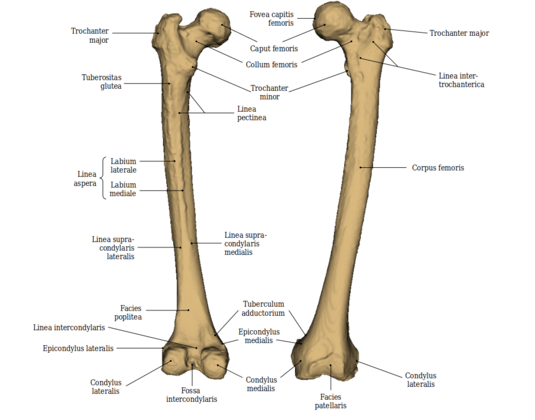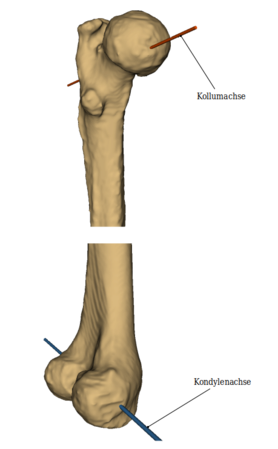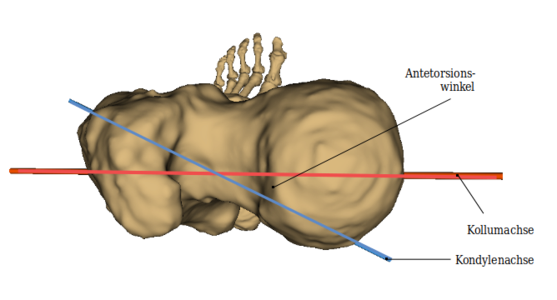Femur
Inhaltsverzeichnis
General information
The thigh (femur) is the part of the leg between hip and lower leg. The bony basis is the femur (Os femoris). This tubular bone is filled inside with spongy bone trabeculae (Spongiosa). Thus, a high stability is achieved with a low weight. With age, the proportion of bone trabeculae decreases, which causes the bone to break more quickly.
| left lower extremity | left femur | right femur |
<segmenter>https://dornheim.cloud/index.php/apps/segmenter/embedding/view?identifier=IX5iSfKVXeXr</segmenter>
Anatomy of the bone
Head (Caput ossis femoris)
The head has an almost spherical joint surface. This is connected to the pelvic bones and thus forms the hip joint. In the middle of the head is the hip basket pit (Fovea capitis femoris). This cavity is the point of passage for a ligament (ligamentum capitis ossis femoris), which surrounds the artery supplying the femoral head. The head merges into the femoral neck at a slight angle.
Neck (Collum ossis femoris)
The femoral neck becomes thicker from proximal to distal and is flattened from ventral to dorsal.
At the lateral end of the neck there are two bony humps, so-called rolling hills. The large trochanter (trochanter major) is located ventrally. It forms a starting point for the gluteal muscles. The dorsal small trochanter (trochanter minor) also serves as a starting point for various thigh muscles. Another starting point for the muscles is a depression (trochanteric fossa) between the neck and the large trochanteric mound as well as the connections between the two trochanteric mounds. Ventrally, the two mounds are connected via the Linea intertrochanterica and dorsally via the Crista intertrochanterica.
Shaft (Corpus femoris)
The shaft forms the strong middle part of the thigh bone and begins below the rolling mounds. The dorsally located reinforcement bar (Linea aspera) serves as an attachment for almost all femoral adductors, but also ensures high stability with a small diameter.
The Linea aspera consists of a central (Labium medial) and a lateral groin (Labium lateral). In the middle of the shaft both groins are still close together. However, they divide up and down. Proximally, the labium laterale merges into a rough surface ( tuberositas glutaea) and the labium medial is continued by the line pectina under the small rolling mound. Distally the two groins divide into the Linea supracondylaris medialis and Linea supracondylaris lateralis. These two lines limit the triangular bone field Facies poplitea.
Lower End
At the lower end the femur is widened to two outwardly curved articular gnarls (condylus medialis and lateralis) covered with cartilage. Together with the tibia (tibia) they form the knee joint. In the front, the gnarls unite to form an outwardly curved joint surface (Facies patellaris). This forms the connection to the kneecap. In addition, the gnarls each have small bony protrusions as an attachment (Epicondylus medialis and Epicondylus lateralis). At the back, a pit (Fossa intercondylaris), limited by the Linea intercondylaris, separates the two joint gnarls from each other.
Axes and angles
Collum axis
The collum axis (also called femoral neck axis) describes the longitudinal axis of the femoral neck.
Condylar axis
The condyle axis is the anterior border of the fossa intercondylaris and thus represents a condyle bisector.
CCD angle
The angle between the longitudinal axis of the femoral neck and the major axis of the shaft is called the Centre-Collum-Diaphyseal Angle (CCD angle). Depending on age and sex, the angle varies. In newborns and infants the angle is up to 150 degrees. With increasing age, it decreases steadily and finally reaches 120 to 130 degrees in adults. Due to the changed strain on the bones during growth, there is a continuous bone remodelling. This is the reason for the change in the CCD angle with advancing age.
Antetorsion angle
The torsion angle is the twisting of the transverse axes of the distal and proximal femoral end. The distal end is turned inwards (towards the median plane) by about 12-20 degrees compared to the proximal end.
weiterführende Links


